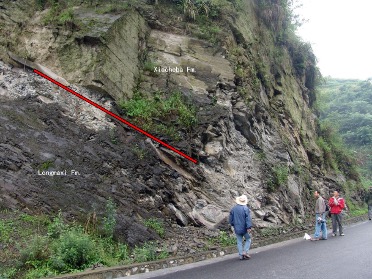Xiaoheba Fm
Type Locality and Naming
It was named by Chang Longqing (1933). The type section is located at Xiaoheba, 25 km south of the Nanchuan County seat in southern Sichuan Province. Hou Defeng (1944) named the central part of the Silurian strata exposed in Penshui, Shizhu and Qianjiang of southern and southeastern Sichuan Province “the Erpoglyph Quartzite”, which corresponds the Xiaoheba Fm.
Synonym: (小河坝组); Hsiaohopa Fm
Lithology and Thickness
In the type section: Lower part, about 190 m in thickness, of the formation consists of medium- to thick-bedded green gray siltstone, partly with thin-bedded bioclastic limestone and yields minor anthozoa, brachiopod and trilobite. Upper part, approximately 300 m thick, is composed of yellow green, gray green shale and silty shale, intercalated with thin-bedded biolithite or limestone lenses, and often bears trace fossils and ripple marks; the biolithite may contain rich anthozoa and minor brachiopod, Bryozoa, crinoid, etc.
[Figure. The Xiaoheba Fm at Rongxi section, Xiushan, Chongqing]
Relationships and Distribution
Lower contact
The Xiaoheba Fm rests conformably onto the underlying Longmaxi Fm (Figure).
Upper contact
The Xiaoheba Fm rests conformably below the overlying Rongxi Fm
Regional extent
The Xiaoheba Fm is mainly distributed in southern and eastern Sichuan Province. It is steady in lithological and biological facies and the thickness ranges from 350~500 m. The spheroidal weathering makes it easy to be recognized. The sandstone of the Xiaoheba Fm is facies-changed into limestone of the Shiniulan Fm; however, the top of the coverage-expanded Xiaoheba Fm is slightly higher than the Shiniulan Fm in horizon. The formation can also be comparable with the upper part of the Xiangshuyuan Fm, the Leijiatun Fm and the Majiaochong Fm in northeastern Guizhou Province.
GeoJSON
Fossils
Yet no detailed research is made on fossils at the type section. Based on data from other relevant sections the formation yields brachiopods Isorthis, Dolerorthis, Spirigerina, Zygospiraella; anthozoa Syringopora, Amplexoides; graptolites Pristiograptus xiushanensis, Petalolithus; trilobite Latiproetus; crinoid Petalocrinus.
Age
Depositional setting
Additional Information
